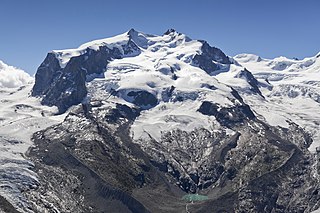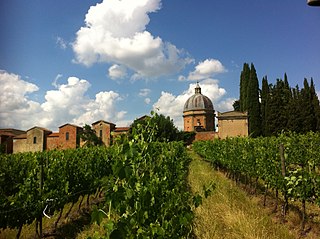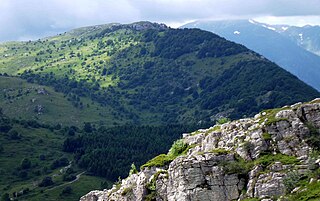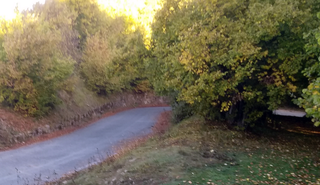
The province of Siena is a province in the Tuscany region of Italy. Its capital is the city of Siena.

Monte Rosa is a mountain massif in the eastern part of the Pennine Alps. It is between Italy's and Switzerland's (Valais). Monte Rosa is the second highest mountain in the Alps and western Europe, after Mont Blanc.

The Val di Chiana, Valdichiana, or Chiana Valley is an alluvial valley of central Italy, lying on the territories of the provinces of Arezzo and Siena in Tuscany and the provinces of Perugia and Terni in Umbria.

Bric delle Camere is a mountain in northern Italy, part of the Ligurian Appennines. It is located in the provinces of Genoa and Alessandria. It lies at an altitude of 1016 metres.

Ronco di Maglio is a mountain in Liguria, northern Italy, part of the Ligurian Alps.

Monte Armetta is a mountain in Piedmont, northern Italy, part of the Alps. At an altitude of 1,739 metres is the highest summit of the Ligurian Prealps.

Rocca Barbena is a 1,142-metre (3,747 ft) high mountain in the Ligurian Prealps in Italy.

Monte Monega is a 1,882-metre (6,175 ft) mountain of the Ligurian Alps, in Italy.

The Passo della Teglia (1385 m) is a mountain pass in the Province of Imperia (Italy). It connects Rezzo with Molini di Triora.

Carmo di Brocchi is a 1,610-metre (5,282 ft) mountain of the Ligurian Alps, in Italy.

Monte Alpesisa is a 989 metres high mountain in the Ligurian Apennines, in Italy.

The Monte Capio is a mountain in the Pennine Alps of north-western Italy; with an elevation of 2,172 m (7,126 ft) is one of the highest peaks of the Alpi Cusiane.

The Monte della Guardia is a mountain in Piedmont, northern Italy, part of the Alps. At an altitude of 1,658 metres is one of the highest summits of the Ligurian Prealps.

The Monte Civrari is a mountain of the Graian Alps, with an elevation of 2,302 m.

The Monte Antoroto is a mountain of the Ligurian Alps located in Piedmont.

The Monte Capezzone is a mountain in the Pennine Alps of north-western Italy; with an elevation of 2,421 m (7,943 ft) is the highest peak of the Strona Valley.

The Monte Zeda is a mountain in the Lepontine Alps belonging to the Province of Verbano-Cusio-Ossola (Italy).

The Monte Birrone is a 2,131-metre (6,991 ft) high mountain in the Cottian Alps, belonging to the Italian province of Cuneo.

The Punta Mirauda is a mountain of the Ligurian Alps located in Piedmont.

Monte Cianea is a 1,226-metre (4,022 ft) mountain of the Ligurian Alps, in Italy.





















